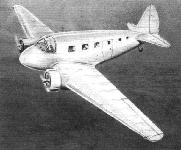
Описание
Страна : Великобритания
Год : 1936
(проект)
Flight, March 1936
TWO BRITISH NEWCOMERS
Monoplane Trainer and Fast Transport Monoplane: Interesting Designs by C.L.W. Company at Gravesend
FROM Gravesend Airport comes news of a new British make of aeroplane, to be produced in contrasting types. The constructors are the C.L.W. Aviation Co., Ltd. (well known in connection with the C.L.W. patented wing), the directors of which are Messrs. S. Wilding-Cole, O.B.E., W. P. Mackinson, A. Levell, F. S. Welman, and Sqn. Ldr. F. W. H. Lerwill, O.B.E.
The first two machines are a two-seater low-wing trainer - of a type which should be particularly suitable for instruction preparatory to flying modern high-performance military and other machines - and a twin-engined transport monoplane. The former will be the first to appear (the transport will be built only to order), and, all being well, it should be flying next month.
<...>
The Transport Monoplane
Due mainly to the incorporation of the C.L.W. type wings, the twin-engined transport monoplane is designed to carry a proportionately heavy payload, and as a result of good aerodynamic design should have a high cruising speed.
In general layout it is a cantilever monoplane. Its tapered wings, which are of duralumin tubes and channels, have a centre section parallel in chord. Unlike the outer panels, which are fabric-covered, this section is covered with dural sheet and is filleted into the fuselage. The main spar is continuous through the fuselage, and torsional loads are taken by continuous tubes.
The fuselage, a dural monocoque structure, has frames of lipped channel section with stringers of angle section, and is covered with flush-riveted dural sheet.
The tail plane is built integral with the fuselage; the elevators and rudder have servo flaps for trimming; and control surfaces have fabric covering with leading edges and fillets of dural. Not only the main undercarriage but the tail wheel is completely retractable, the former into the engine nacelles.
Well forward in the nose is the pilot's cockpit, with windscreen of Triplex and top and sides of Rhodoid. The main seven-passenger cabin is entered from a door on the port side, and is 12ft. 0in. long, 5ft. 1in. high, and has an average width of 4ft. 4in. Behind this is a lavatory of 45 cu. ft. capacity. Yet further aft is the luggage compartment (capacity 34 cu. ft.).
Originally the C.A.1 was designed to take the 270 h.p. Siddeley Cheetah V radial of 270 h.p., and with two of these units the estimated speed at sea level is 209 m.p.h. With the 290/320 h.p. moderately-supercharged Cheetah IX, the maximum speed at altitude should be considerably increased. The unsupercharged engines should give a cruising speed of 203 m.p.h.
The main dimensions are: Span, 52ft.; length, 32ft. 3in.; height, 10ft. 0in. The tare weight is 3,152 lb., and fully loaded the machine weighs 6,100 lb., or 6,400 lb. in "overload" condition. The wing loading is 21.3 lb./sq. ft.
- Flight, March 1936
TWO BRITISH NEWCOMERS
Фотографии
-
Flight 1936-03 / Flight
The projected C.L.W. twin-engined transport, with two Siddeley Cheetahs.
- Фотографии
